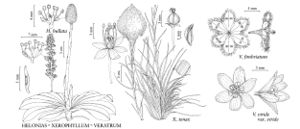Veratrum fimbriatum
Proc. Amer. Acad. Arts 7: 391. 1868.
Stems 1–2 m, densely tomentose distally. Leaves elliptic-lanceolate, reduced distally, 20–50 × 10–25 cm, glabrous or sparsely hairy. Inflorescences paniculate, with spreading to ascending branches, 30–50 cm, densely tomentose; bracts ovate to ovate-lanceolate, shorter than flowers. Tepals white, rhomboid-ovate to ovate, not clawed, 6–9 mm, margins ± deeply and irregularly fimbriate; glands 2, basal, ± mid tepal, yellow, elliptic; ovary glabrous; pedicel 6–12 mm. Capsules oblong-ovoid, 8–10 mm, glabrous. Seeds ± globose, wingless, 5–7 mm. 2n = 32.
Phenology: Flowering summer–early fall.
Habitat: Wet meadows in coastal scrub
Elevation: 0–100 m
Discussion
This showy Veratrum species differs from others in its fragrant flowers with deeply fringed tepals, wingless seeds, and auxiliary bulbs in the lower leaf sheaths, and is restricted as a paleo-endemic to a 96-km coastal stretch of Sonoma and Mendocino counties (C. A. Taylor 1956, 1956b).
Selected References
None.

